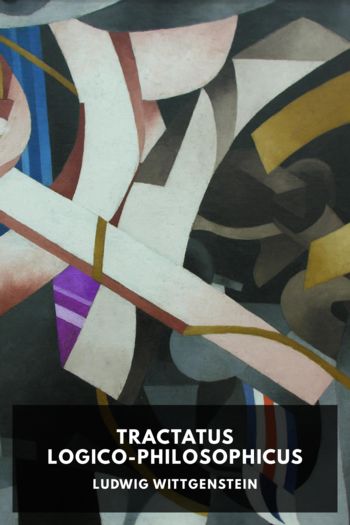Tractatus Logico-Philosophicus - Ludwig Wittgenstein (top 10 ebook reader TXT) 📗

- Author: Ludwig Wittgenstein
Book online «Tractatus Logico-Philosophicus - Ludwig Wittgenstein (top 10 ebook reader TXT) 📗». Author Ludwig Wittgenstein
The truth-grounds of q are contained in those of p; p follows from q.
5.122If p follows from q, the sense of “p” is contained in that of “q”.
5.123If a god creates a world in which certain propositions are true, he creates thereby also a world in which all propositions consequent on them are true. And similarly he could not create a world in which the proposition “p” is true without creating all its objects.
5.124A proposition asserts every proposition which follows from it.
5.1241“p.q” is one of the propositions which assert “p” and at the same time one of the propositions which assert “q”.
Two propositions are opposed to one another if there is no significant proposition which asserts them both.
Every proposition which contradicts another, denies it.
5.13That the truth of one proposition follows from the truth of other propositions, we perceive from the structure of the propositions.
5.131If the truth of one proposition follows from the truth of others, this expresses itself in relations in which the forms of these propositions stand to one another, and we do not need to put them in these relations first by connecting them with one another in a proposition; for these relations are internal, and exist as soon as, and by the very fact that, the propositions exist.
5.1311When we conclude from p∨q and ~p to q the relation between the forms of the propositions “p∨q” and “~p” is here concealed by the method of symbolizing. But if we write, e.g. instead of “p∨q” “p|q.|.p|q” and instead of “~p” “p|p” (p|q = neither p nor q), then the inner connection becomes obvious.
(The fact that we can infer fa from (x).fx shows that generality is present also in the symbol “(x).fx”.
5.132If p follows from q, I can conclude from q to p; infer p from q.
The method of inference is to be understood from the two propositions alone.
Only they themselves can justify the inference.
Laws of inference, which—as in Frege and Russell—are to justify the conclusions, are senseless and would be superfluous.
5.133All inference takes place a priori.
5.134From an elementary proposition no other can be inferred.
5.135In no way can an inference be made from the existence of one state of affairs to the existence of another entirely different from it.
5.136There is no causal nexus which justifies such an inference.
5.1361The events of the future cannot be inferred from those of the present.
Superstition is the belief in the causal nexus.
5.1362The freedom of the will consists in the fact that future actions cannot be known now. We could only know them if causality were an inner necessity, like that of logical deduction.—The connection of knowledge and what is known is that of logical necessity.
(“A knows that p is the case” is senseless if p is a tautology.)
5.1363If from the fact that a proposition is obvious to us it does not follow that it is true, then obviousness is no justification for our belief in its truth.
5.14If a proposition follows from another, then the latter says more than the former, the former less than the latter.
5.141If p follows from q and q from p then they are one and the same proposition.
5.142A tautology follows from all propositions: it says nothing.
5.143Contradiction is something shared by propositions, which no proposition has in common with another. Tautology is that which is shared by all propositions, which have nothing in common with one another.
Contradiction vanishes so to speak outside, tautology inside all propositions.
Contradiction is the external limit of the propositions, tautology their substanceless centre.
5.15If Tr is the number of the truth-grounds of the proposition “r”, Trs the number of those truth-grounds of the proposition “s” which are at the same time truth-grounds of “r”, then we call the ratio Trs:Tr the measure of the probability which the proposition “r” gives to the proposition “s”.
5.151Suppose in a schema like that above in No. 5.101 Tr is the number of the “T”’s in the proposition r, Trs the number of those “T”’s in the proposition s, which stand in the same columns as “T”’s of the proposition r; then the proposition r gives to the proposition s the probability Trs:Tr.
5.1511There is no special object peculiar to probability propositions.
5.152Propositions which have no truth-arguments in common with one another we call independent.
Independent propositions (e.g. any two elementary propositions) give to one another the probability ½.
If p follows from q, the proposition q gives to the proposition p the probability 1. The certainty of logical conclusion is a limiting case of probability.
(Application to tautology and contradiction.)
5.153A proposition is in itself neither probable nor improbable. An event occurs or does not occur, there is no middle course.
5.154In an urn there are equal numbers of white and black balls (and no others). I draw one ball after another and put them back in the urn. Then I can determine by the experiment that the numbers of the black and white balls which are drawn approximate as the drawing continues.
So this is not a mathematical fact.
If then, I say, It is equally probable that I should draw a white and a black ball, this means, All the circumstances known to me (including the natural laws hypothetically assumed) give to the occurrence of





Comments (0)